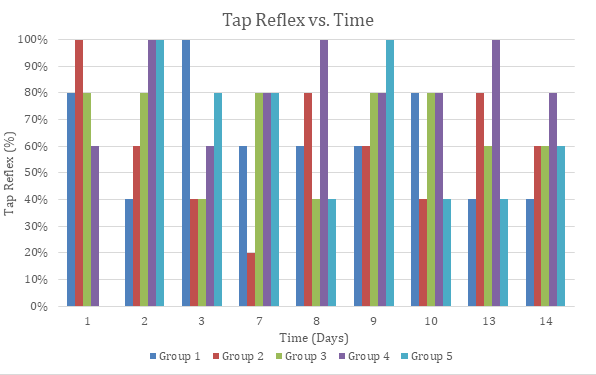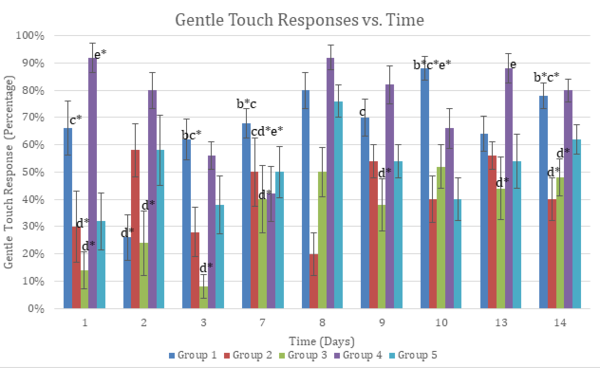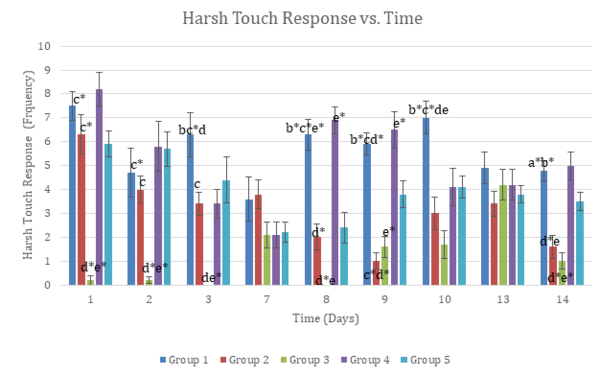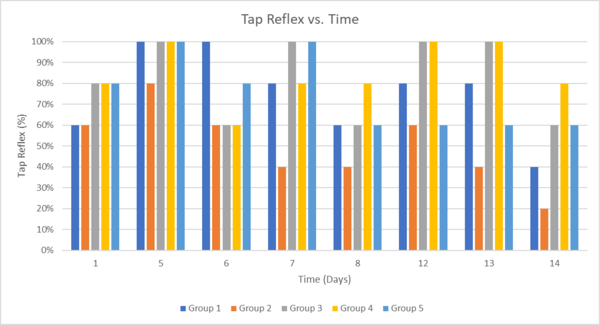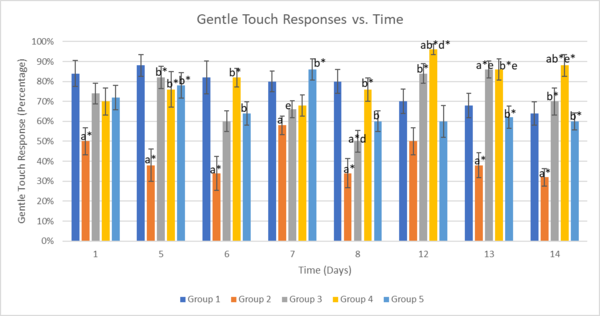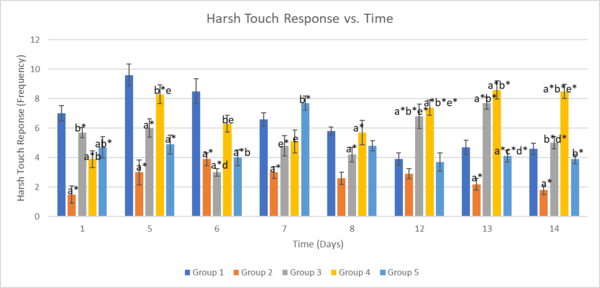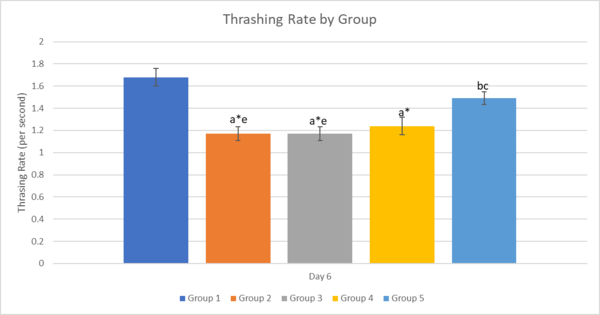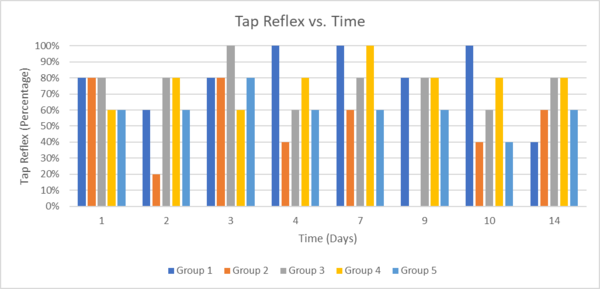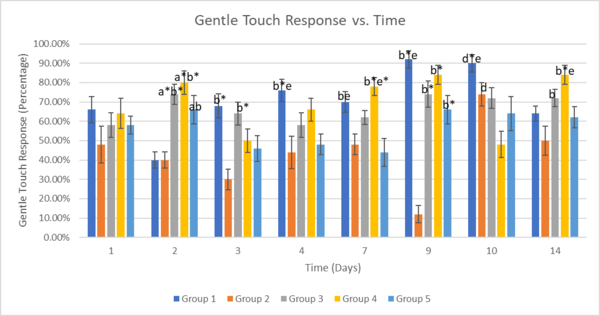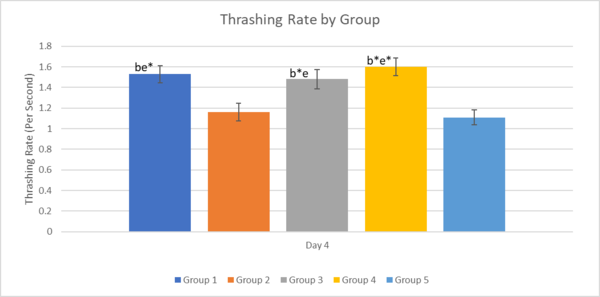Abstract
The effect of Astragalus membranaceus on Caenorhabditis elegans was assessed in this experiment. Parkinson’s Disease directly causes dopamine depletion and other related symptoms. Astragalus contains complex carbohydrates linked to dopamine neuron protection, which could be used to treat Parkinson’s. In this experiment, C.elegans inflicted with Parkinson’s were treated with different concentrations of astragalus. C.elegans are free-living nematodes that can be genetically engineered to model or stimulate various diseases caused by genetics, Parkinson’s being one of them. The concentrations of astragalus solution were 2 mg/mL, 4 mg/mL, and 8 mg/mL, which were added to the agar that the C.elegans inhabited. Mechanosensory tests included tap reflex and gentle and harsh touch assessment. M9 Buffer was used to inhibit the egg-laying behaviors of C.elegans, and the thrashing rate was assessed for each group. The results indicate that 4 mg/mL is the optimal concentration to treat disease-inflicted C.elegans and had the best results out of the 3 trials. The 4 mg/mL group constantly had the highest tap reflex, gentle, and harsh touch scores that were similar or greater than the wild-type control group. Additionally, the 2 mg/mL also had high scores in trials 2 and 3 in both the gentle and harsh touch assessments. No definite conclusions can be determined from thrashing rate data. The results imply that lower and intermediate concentrations of Astragalus may treat the symptoms of Parkinson’s Disease.
Introduction
Parkinson’s Disease
Parkinson’s Disease (PD) is a hereditary brain disorder that gradually progresses with age. According to the Parkinson’s Foundation, Parkinson’s disease affects more than ten million people above the age of fifty worldwide, making it the second most common neurodegenerative disease behind Alzheimer’s (“Parkinson's Foundation,” n.d.). The ultimate cause of PD is cell death within the brain’s basal ganglia region relating to the production of dopamine. The root cause of cell death is still unknown; however, genetic, and environmental factors can affect cell death (“U.S. Department of Health and Human Services,” n.d.). PD is familial and derived from the mutations of the SNCA/PARK1 gene which codes for the ɑ-synuclein protein. ɑ-Synuclein then creates Lewy bodies, which can cause a depletion of neurotransmitters such as dopamine.
Oxidative stress is also a key factor in the development of Parkinson’s Disease. Reactive oxygen species (ROS) are unstable molecules that can cause damage to a cell’s DNA and proteins. A significant amount of oxygen consumed by the brain is converted to ROS which directly affects the dopamine neurons (Johnson et al., 2012). The source of ROS is the mitochondrion, where free radicals from the electron transport chain combine with oxygen. As a result, this produces ROS which can escape into the cell cytoplasm and cause cell damage. The central nervous system contains many mitochondria to function which would increase the vulnerability of dopamine neurons to ROS. ROS can cause damage to the dopamine neurons by targeting their DNA and causing DNA damage. Oxidative damage of DNA can alter the transcription and translation of proteins within the dopamine neurons, which may be irreversible (Guo et al., 2018). Additionally, oxidative stress can cause aggregation of ɑ-Synuclein which again builds up Lewy bodies and causes inflammatory responses within the brain. A positive feedback loop is also established where the aggregation of ɑ-Synuclein causes increased ROS production which causes more aggregation and creates a cycle towards neurodegeneration (Dias et al., 2013). Thus, a treatment that contains antioxidant properties would be helpful in tending to oxidative stress.
The deterioration of dopamine neurons causes most of the symptoms related to PD, which include motor impairments and cognitive dysfunctions (Di Rosa et al., 2020). Motor impairments include fatigue, irregular blood pressure, tremors, and stiffness in limbs not to mention the psychological damage it causes.
Treatments for PD mostly target prominent symptoms of the disease such as dopamine depletion since no one has discovered an absolute cure for PD. Pharmacotherapy treatment is one of the common treatments for PD by using dopaminergic agents and other medicinal drugs. As a common treatment, levodopa can treat the symptoms of PD by rapidly forming dopamine directly in the brain. However, levodopa does not fully treat PD symptoms such as tremors and motor fluctuations, or other adverse effects like hypertension and nausea (LeWitt, 2008). Therefore, many other experimental treatments such as nicotine and selenium were evaluated for effectiveness in past studies (Singh et al., 2007). These treatments are both associated with the release of dopamine to treat PD symptoms. However, many of these treatments come with complications as nicotine can cause addiction and selenium can cause headaches and discomfort.
Antioxidant treatments were also studied in their effectiveness in treating PD. Past studies have suggested antioxidant enzymes play a factor in counteracting damage caused by oxidative stress. Because the activity of antioxidant enzymes decreases in neurodegenerative states, supplementing patients with antioxidants has been discussed (Ghosh et al., 2011). However, most clinical treatments with antioxidants had only modest effect on the progression of PD. Dietary treatments such as Vitamin E were tested to patients with early PD which did not reduce PD risk or improve cognitive function (Scheider et al., 1997). Some antioxidants show more promising results such as melatonin which stimulates the expression of antioxidant enzymes but there is little clinical research done on humans (Filograna et al., 2016). Despite these results, a treatment for PD should still involve antioxidant effects for it to have the possibility of reversing or preventing further neurodegeneration. The synthesis of a cost-efficient treatment with minimal adverse effects should improve the conditions of PD patients.
Astragalus membranaceus
Astragalus membranaceus is a type of traditional Chinese medicine also called Huang-qi. The Astragalus root has medicinal purposes such as a dietary supplement or treatment for respiratory diseases (“U.S. Department of Health and Human Services,” 2020). The main components are the Astragalus polysaccharide (APS) also known as Astragalan, which is extracted from the roots of the plant. APS are complex polymeric carbohydrates linked by ɑ-type glycosidic bonds. The main components include heteropolysaccharides, dextran, neutral polysaccharide, and acidic polysaccharide (Zheng et al., 2020). APS is primarily an antioxidant that many use for anti-aging purposes as it attacks the free radicals that cause tissue damage and has anti-inflammatory and antibacterial properties. Researchers also evaluated APS on the immune organs in mice which helped improve the swollen or deteriorated thymus and the spleen (Yu et al., 2018). Astragalus has beneficial effects on animal models that may exhibit similar effects on humans.
The antioxidative properties of Astragalus would be useful in treating ROS and oxidative stress. Root extracts of Astragalus can scavenge for free radicals since it contains rich components of secondary metabolites. Astragalus can also inhibit key enzymes such as acetylcholinesterase that are linked to the pathogenesis of PD (Sekeroglu & Geziei 2019). ROS levels and inflammation can also be reduced by using astragalus. Previous studies used APS on human cell lines inflicted with bronchopulmonary dysplasia and uncovered that APS inhibits oxygen free radicals and protects cells from oxidative stress (Huang et al., 2013).
The neuroprotective aspects of Astragalus have mostly been experimented on in mice. Experimenters tested Astragalus extract on mice induced with Aβ (25-35), which causes atrophic neurites (the deterioration of neurons). Atrophic neurites can cause neurological diseases such as Alzheimer’s, Parkinson’s, and others. Previous research used astragalus extract to reverse the effects of Aβ (25-35) and protected the neurons from dying as well as promote axonal regeneration (Tohda et al., 2006). Additionally, mice that experimenters inflicted with PD were also treated with astragalus extract. When experimenters injected 1-methyl-4-phenyl-1,2,3,6-tetrahydropyridine (MPTP) into mice, MPTP destroys the dopamine neurons of the mice and causes symptoms of Parkinson's. After a few weeks of APS injections, the treatment group experienced alleviations in symptoms. The experimenters assessed behavioral injury of the mice due to the MPTP through a pole climbing test, the mice injected with APS climbed down faster than the treatment-less group (Liu et al., 2018). In summary, astragalus treatment exhibits potential in caring for neurodegenerative diseases.
Caenorhabditis elegans
Caenorhabditis elegans (C. elegans) is a free-living transparent nematode worm commonly used as an animal model. C.elegans are only three cells in radius and can grow up to one millimeter long as an adult and contain simple forms of organ systems such as nervous, reproductive, and digestive systems. Since the worm is transparent and can rapidly reproduce either by self-fertilization or mating it is an especially useful animal to study development and genetic tools. C.elegans lifespan spans from 2 to 3 weeks and takes around 3 days for the animal to develop into an adult under optimal conditions. The stages of development of C. elegans contain the embryo stage, four larval stages (L1-L4), and eventually adulthood, however, the absence of food or environmental stresses can cause the worm to halt development and go into a stage called Dauer larva. With exposure to more favorable conditions, the worm will eventually exit out of the Dauer stage and continue development (Altun & Hall 2009).
Temperature and food are major developmental factors that affect the growth of the worms depending on the stages of the worm. Lower temperatures such as 15℃ can extend the lifespan of already adult worms; however, for larva, it shortens their adult lifespan after developing into an adult. Higher temperatures such as 25℃ had the opposite effect and extended adult lifespan after storing larvae at that temperature. Temperature experience in the earlier stages of worm development can severely affect the worm during later stages (Zhang et al., 2015). Therefore, it is imperative to store the worms at around 20℃ as a medium temperature. Food is another important aspect of growth for the worms. C.elegans feeds on the non-pathological bacterial strain E. coli OP50 that experimenters typically grow on Nematode Growth medium (NGM) (Stiernagle 2006). The absence of food also causes different effects on various stages of worms, stresses such as limited food cause L1 to molt into the Dauer stage as mentioned before. Dauer larvae are nonfeeding and morphologically different from the regular larvae groups, Dauer worms postpone growth and reproduction until feeding resumes. Additionally, the movement and locomotion of the worms slow down as well as other behavior aspects, however, the worms can survive for months and can return to regular reproductive worms after exposure to more favorable conditions (Baugh & Hu 2020).
C.elegans has major potential when it comes to studying genetic disorders and mutations. Researchers can perform rapid genetic crosses to study how a specific mutation affects the line of progeny. A method to introduce mutations and even genetic disorders would be using RNA interference (RNAi). RNAi uses genetically engineered bacteria that express the desired gene and feed them to the worms, which then can cause genetic knockdown of the specific sequence. In other cases, microinjections of DNA into the worm can produce transgenic C. elegans that can overexpress proteins and allow heritable genetic modifications (Apfeld & Alper 2018). These genetic tools can create transgenic worms that model after human diseases such as PD. For example, the Caenorhabditis Genetics Center from Minnesota University contains over 20,000 transgenic strains of C. elegans, many of which are strains that exhibit diseases like Alzheimer's and PD. In the case of Parkinson's, NL5901 is one of the strains that contain the ɑ-synuclein protein. The ɑ-synuclein protein causes the creation of Lewy Bodies which then has several physical and behavioral effects on the worm like human PD. ɑ-synuclein can slow down the locomotive movement of C.elegans when compared to normal wild worms and had slower pharyngeal pumping rate (Bodhicharla et al., 2012). One major impact would be the loss of dopamine neurons, C. elegans contains eight dopamine neurons in total as well as damage to those neurons. This damage to the neurons can affect many dopamine-dependent behaviors that C. elegans expresses (Cooper & Raamsdonk 2018).
C.elegans exhibit simple behaviors that can assess neurological health when observed. The loss of dopamine neurons affects behaviors such as basal and feeding slowing. Basal slowing is the slowing of locomotion in the presence of food or bacteria, the decrease in dopamine signals the animal to crawl faster (Cooper & Raamsdonk 2018). Thrashing rate in liquid is another example of effects on locomotive behaviors. The motor deficit is a major component of PD in both humans and C. elegans as dopamine controls the transition between crawling and swimming. Dopamine slows down the worm to switch from crawling to swimming, the C. elegans with PD experience a form of paralysis when placed into a liquid. Dopaminergic neurons also control the mechanosensory responses of the worm to outside stimuli. Experimenters often resort to tap reflex to assess this behavior; the worm responds to the tapping of the petri-dish either by moving forward or backward, and the number of times would evaluate its reactivity. Experimenters also used other tests to assess mechanosensory responses such as gentle touch or harsh touch which experimenters score in similar ways as the tap reflex (Maulik et al., 2017). Mechanosensory responses are also subjected to habituation, for example, repeated stimulation can cause a decrease in wild-type worms to exhibit tap-reversal, aka tap habituation. However, dopamine can influence habituation, a mutant in the dopamine receptor dop-1 causes rapid tap habituation compared to wild-type (Sanyal et al., 2004). Therefore, this means that C. elegans with neuron impairment may exhibit habituation more quickly than normal which can cause them to become non-reactive faster than wild type. Overall, dopamine controls the simple animal behaviors that C. elegans exhibits which assess neurological health.
C.elegans Parkinson’s Treatment
Several different treatments for PD have been experimented on C. elegans. Plant extracts such as Ayurvedic nootropics were used on C. elegans PD models. The worm strains used were NL5901 and BZ555 which are strains that expresses green fluorescent proteins in dopamine neurons to allow better observations. Although the NL5901 strain exhibits PD, the BZ555 strain cannot create ɑ-synuclein naturally, therefore, the use of MPTP stimulated the effect of PD. The ayurvedic nootropic was able to inhibit a-synuclein aggregation and the herbs used on the MPTP-induced C. elegans were found to prevent dopamine degeneration (Anjaneyulu et al., 2020). Therefore, there were plant extracts that helped against PD in transgenic C. elegans. Astragalus may be one of those treatments, however, Astragalus has not experimented on transgenic C. elegans with PD yet. Despite this, experimenters tested APS on PD-induced C. elegans using 6-Hydroxydopamine (6-OHDA) which is a neurotoxin that can degenerate dopaminergic neurons. BZ555 was again used in this experiment and was exposed to 6-OHDA but treatment groups were treated with different concentrations of Astragalan. Experimenters tested concentrations of Astragalus from 0.5 mg/ml to 4 mg/ml and the results showed that increased concentrations of astragalus were able to improve dopamine neuron viability. Additionally, behaviors such as basal slowing improved the most for the 4 mg/ml treatment group, 2 mg/ml astragalus also managed to significantly increase the lifespan of the nematodes (Li et al., 2016). Astragalus was able to counteract the harmful effects of 6-OHDA and normalize the neurological behavior of the C. elegans.
Despite experimenters using astragalus to treat C. elegans with induced PD, there are no specific experiments on its effects on transgenic C. elegans. Strains such as NL5901 were modified to make ɑ-synuclein protein like humans, making it a much more effective model than inducing C. elegans with neurotoxins to stimulate PD. Therefore, astragalus should be tested on this strain to further test its efficiency to treat PD. Additionally, there is little research done to test the mechanosensory responses of C. elegans influenced by PD or how treatment of PD affects it. Therefore, this experiment tested transgenic strain NL5901 treated with astragalus with mechanosensory responses.
This experiment will benefit human life if the data suggests that the C. elegans treated with astragalus became more responsive to the touch responses. This experiment can lead to more research done on the treatment of astragalus supplements for Parkinson’s Disease in human subjects. The research done in this experiment also helps to model the effect of Astragalus on the mechanosensory aspects of C. elegans particularly gentle and harsh touch which is not thoroughly researched. This research also tested the optimal concentration of astragalus which could be studied further to treat PD.
Methods and Materials
Table 1: Experimental Setup
| Strain | Plant Treatment Concentration (mg/ml) | Treatment amount | Petri-dish label | M9 Buffer Amount |
Bacteria Culture | |
| Group 1 | Wild | 0 | 5 mL of deionized water | LBC-I-01 | 1 mL | OP50 |
| Group 2 | NL5901 | 0 | 5 mL of deionized water | LBC-I-02 | 1 mL | OP50 |
| Group 3 | NL5901 | 2 | 5 mL of plant treatment | LBC-I-03 | 1 mL | OP50 |
| Group 4 | NL5901 | 4 | 5 mL of plant treatment | LBC-I-04 | 1 mL | OP50 |
| Group 5 | NL5901 | 8 | 5 mL of plant treatment | LBC-I-05 | 1 mL | OP50 |
Astragalus Preparation
The Astragalus root supplement was obtained from “The Vitamin Shoppe” in 500-gram capsules and used to create a solution with deionized water. A serial dilution helped create the solution and allowed for less human error when measuring out the solution. This also allowed for the proper number of milliliters of the solution to be created while keeping the desired amount of plant treatment concentration. 200 mL of deionized water was poured into a graduated cylinder and poured into a large beaker. Astragalus supplements were obtained by uncapping the capsules and weighing them on an electric scale until 1600 milligrams of the powder were weighed out. Then, the powder was added to the beaker of deionized water and was stirred well using a glass stirring rod. Once the powder was well mixed into the water, 100 mL of the solution was measured out by pouring it into a graduated cylinder. The one hundred millimeters were then added to a separate beaker and another 100 mL of water was added to dilute the solution. This created two beakers of the solution, the original that is now 100 mL of 8 mg/ml astragalus solution, and the new which was 200 mL of 4 mg/ml solution. 100 mL of the solution from the 200 ml beaker was then measured out and poured into a new beaker. Then 100 mL of water was added to dilute the solution further, creating a 2 mg/ml solution. The final solution concentrations and amount were 100 mL of 8 mg/ml, 100 mL of 4 mg/ml, and 200 mL of 2 mg/ml solution.
Agar Plate Preparation
Nematode growth medium (NGM) was acquired from “Carolina Biological Supply Company” and was used to stimulate the growth of C. elegans. The agar was prepared by heating the agar bottle in a large beaker filled with water on a hot plate. The hot plate was used at the maximum setting until the agar melted and was poured evenly into individual Petri dishes. The NGM was distributed into five Petri dishes each labeled according to the treatment given shown in Table 1. Five milliliters of the astragalus solution were added to each Petri-dish of agar aside from the control groups (Group 1 and 2) which had deionized water. The agar then solidified after 30 minutes of exposure to room temperature and then was flipped upside down and stored in a fridge overnight.
E. coli Preparation
E. coli (OP50) was provided by the Caenorhabditis Genetics Center (CGC) from The University of Minnesota and the E. coli was shipped with the C. elegans. The bacteria were previously streaked by the CGC onto a small Petri dish of agar labeled “OP50” and would serve as food for the C. elegans. An inoculating loop was used to cut and scoop a cube of the agar and place it onto the Petri dish. Each Petri dish of C. elegans received an evenly sized chunk of the streaked agar from the CGC, the inoculating loop was flamed in between transfers to sterilize. After transferring the E. coli onto the dish, it was gently spread around the center of the Petri-dish using the loop to facilitate bacterial growth. Then the Petri dishes were sealed with parafilm and incubated at 33℃ overnight.
M9 Buffer Preparation
An M9 buffer was prepared to inhibit the egg-laying behavior of C. elegans. This buffer was created by adding 3.0 grams of Potassium Phosphate (KH₂PO₄), 6.0 grams of Disodium Phosphate (Na2HPO4), 0.5 grams of Sodium Chloride (NaCl), and 1.0 grams of Ammonium Chloride (NH4Cl) to an Erlenmeyer flask, followed by one liter of H20. Each solid ingredient was measured by an electric scale, and all of this was mixed well by a glass rod. Once mixed, the solution was autoclaved at 120 kPa for 20 minutes to sterilize it. The solution was then stored in a glass bottle, sealed by a bottle cap, and labeled.
C.elegans Care
Two orders of C. elegans were received from the CGC starved on a small dish of agar. One order of the wild type “N2” and the other order of “NL5901” strain. The worms were transferred onto the prepared Petri dishes streaked with E. coli and treated with astragalus solution by the chunking method. The inoculating loop was flamed until bright red and cooled on the prepared agar plate before being used to cut and chunk the agar with the worms. A 1 cm by 1 cm cube was cut into the agar and the loop was used to scoop the cube out and transfer it onto the prepared Petri dish. The type of worm was transferred to each of the Petri dishes in correspondence with Table 1. The extra starved worms were kept in the incubator with the rest of the plates and wrapped with parafilm.
The C. elegans were stored in the incubator at room temperature throughout the 2-week experiment. A dissecting microscope was used to observe the Petri-dishes for the C. elegans to make sure that it was properly transferred. The C. elegans were allowed 24 hours to adapt to the new environment and reproduce on the Petri dishes. After the first day, one milliliter of M9 buffer was used on the C. elegans to inhibit reproduction. The Petri dishes were wrapped with parafilm to keep the plates from drying out. After 2 weeks, the Petri dishes were autoclaved and disposed of.
Gentle Touch Assessment
A gentle touch assessment was done on the C. elegans to assess the sensory abilities of the worms. This was done by attaching a piece of eyelash hair to the end of a toothpick using tape and using the hair to gently stroke the C. elegans. This will assess the gentle touch sensitivity of the worms by how many times they move per stroke (Chalfie & Sulstan 1981). Each worm was touched five times by the hair and the movement was observed under the microscope. Ten worms were assessed daily, and the toothpick was sterilized using sanitizing wipes and 70% isopropyl alcohol.
Harsh Touch Assessment
A harsh touch assessment was done on the C. elegans to further assess the mechanosensory capabilities of the worms. The harsh touch assessment was done by using a dissecting metal probe to lightly prod ten different worms per group and counting the amount of erratic thrashing that occurs. Ten worms were assessed daily, and worm movement was counted and recorded on a sheet of paper. The metal probe was sterilized using sanitizing wipes and 70% isopropyl alcohol.
Tap Reflex
Tap reflex of the C. elegans was measured to test how astragalus affected the sensory capabilities of the C. elegans. The Petri dishes were placed under a microscope and adjusted so that at least five worms were in full view. Then the Petri dishes were tapped by the experimenter three consecutive times and erratic movements due to the tapping would be observed. The total number of worms that moves out of the five in view would be recorded.
Thrashing Assessment
The thrashing rate was measured to assess the locomotive capabilities of the worms. One milliliter of M9 buffer was poured into the Petri Dish on day 6. The Petri dishes were placed under a microscope and adjusted so that only one worm is in full focus. The number of C-bends were counted for 10 seconds and recorded on data sheets. Once completed the Petri dish was moved to focus on another worm and the same assessment was done for 10 worms for each group.
Data Collection
Data collection began 24 hours after the C. elegans were initially transferred onto the agar. Data was collected by recording the percentage of C. elegans who responded to tap reflex and the gentle touch assessment, respectively. Within harsh touch assessment, the number of movements after one tap with the dissecting metal probe was recorded. The movement was characterized by the number of “C” bends that the C. elegans made after a stimulus, as well as acceleration or backwards movement. For the gentle touch, the number of responses was counted out of five for each worm. The tap reflex was the number of worms that moved out of the five in view. The harsh touch was the total amount of movement after prodding with the probe for ten worms. The thrashing assessment was measured by counting the number of “C” bends in 10 seconds for 10 worms for every group. Worksheets were created and used to organize data for each individual group on each day. Data from the daily worksheets were transferred to a Microsoft Excel spreadsheet, where graphs could be made to show differences between the groups.
Data Analysis
The data was analyzed using Microsoft excel. The average tap reflex was calculated by dividing the number of worms that moved by five to get a percentage. The average percentage of gentle touch was calculated by adding up the total number of responses and then dividing by 10 (the number of worms assessed) then dividing the average by five to get a percentage out of five. Ergo, an average of 70% would mean that the specific group on average responded to 70% of the five touch responses. The average frequency of the harsh touch responses was calculated by adding up the total number of responses and then dividing by ten. The thrashing assessment was measured by dividing the number of “C” bends by 10 to get the thrashing rate per second. Then, the average thrashing rate was calculated by adding the total number of “C” bends and then dividing by ten. ANOVA followed by Tukey HSD was used to determine the significance of the data.
(https://astatsa.com/OneWay_Anova_with_TukeyHSD)
Graphs
The average tap reflex vs. time (in days) were plotted into a bar graph. This was to show the difference between each group in terms of tap reflex to assess the effectiveness of the treatment. The average response for gentle touch vs. time (in days) were also plotted into a bar graph. Then, the average response for harsh touch vs. time (in days) were also graphed. Both graphs were made to better demonstrate the differences between the groups. The thrashing rates by group were graphed into a bar graph to show the differences between different groups.
Results
Trial 1:
Figure 1: Tap Reflex vs. Time. The C. elegans assessed (n=50) were treated with different concentrations of astragalus: group 1 (control Wild-Type), group 2 (control NL5901), group 3 (2 mg/mL), group 4 (4 mg/mL), group 5 (8 mg/mL). The percentage of worms that responded to tapping on the Petri dish per group was assessed and compared with other groups. Group 4 had the greatest success rate, with an average of around 82% of worms responding to the taps. On the other hand, groups 1 and 2 had the lowest success rate, with around 62% and 60% of worms responding to taps, respectively.
Figure 2: Gentle touch response vs. Time. The C. elegans assessed (n=50) were treated with different concentrations of astragalus: group 1 (control Wild-Type), group 2 (control NL5901), group 3 (2 mg/mL), group 4 (4 mg/mL), group 5 (8 mg/mL). The average gentle touch response percentage between separate groups was compared with each other. ANOVA Tukey HSD was used to evaluate significant differences. The subscript is labeled after the key: a= significant from group 1, b=significant from group 2, c= significant from group 3, d= significant from group 4, e= significant from group 5 (p<0.05). Combined subscripts are significantly different from multiple corresponding groups. Subscripts with asterisks (*) mean the p-value is less than 0.01. Groups on different days were not compared statistically with each other. Many groups are significantly lower than group 4 on separate days. Error bars represent ±SEM.
Figure 3: Harsh Touch Response vs. Time. The C. elegans assessed (n=50) were treated with different concentrations of astragalus: group 1 (control Wild-Type), group 2 (control NL5901), group 3 (2 mg/mL), group 4 (4 mg/mL), group 5 (8 mg/mL). The harsh gentle touch response frequency between separate groups was compared with each other. ANOVA Tukey HSD was used to assess significant differences. The subscript is labeled after the key: a=significant from group 1, b=significant from group 2, c=significant from group 3, d=significant from group 4
e=significant from group 5 (p<0.05). Combined subscripts are significantly different from multiple corresponding groups. Subscripts with asterisks (*) mean the p-value is less than 0.01. Groups on different days were not compared statistically with each other. On many occasions, group 4 had a statistically significantly higher average than other groups. Group 3 had the least average across the trial. Error bars represent ±SEM.
Trial 2:
Figure 1: Tap Reflex vs. Time. The C. elegans assessed (n=50) were treated with different concentrations of astragalus: group 1 (control Wild-Type), group 2 (control NL5901), group 3 (2 mg/mL), group 4 (4 mg/mL), group 5 (8 mg/mL). The percentage of worms that responded to tapping on the Petri dish per group was assessed and compared with other groups. Group 4 and group 3 had the greatest average out of all the groups. Group 2 had the lowest average consistently throughout the trial.
Figure 2: Gentle touch response vs. Time. The C. elegans assessed (n=50) were treated with different concentrations of astragalus: group 1 (control Wild-Type), group 2 (control NL5901), group 3 (2 mg/mL), group 4 (4 mg/mL), group 5 (8 mg/mL). The average gentle touch response percentage between separate groups was compared with each other. ANOVA Tukey HSD was used to evaluate significant differences. The subscript is labeled after the key: a= significant from group 1, b=significant from group 2, c= significant from group 3, d= significant from group 4, e= significant from group 5 (p<0.05). Combined subscripts are significantly different from multiple corresponding groups. Subscripts with asterisks (*) mean the p-value is less than 0.01. Groups on different days were not compared statistically with each other. Group 2 had the lowest average compared to all other groups. Out of the treatment groups, groups 4 and 3 had consistently the highest average. Error bars represent ±SEM.
Figure 3: Harsh Touch Response vs. Time. The C. elegans assessed (n=50) were treated with different concentrations of astragalus: group 1 (control Wild-Type), group 2 (control NL5901), group 3 (2 mg/mL), group 4 (4 mg/mL), group 5 (8 mg/mL). The harsh gentle touch response frequency between different groups was compared with each other. ANOVA Tukey HSD was used to assess significant differences. The subscript is labeled after the key: a=significant from group 1, b=significant from group 2, c=significant from group 3, d=significant from group 4
e=significant from group 5 (p<0.05). Combined subscripts are significantly different from multiple corresponding groups. Subscripts with asterisks (*) mean the p-value is less than 0.01. Groups on different days were not compared statistically with each other. On many occasions, groups 3 and 4 had a statistically significantly higher average than other groups. Group 2 had the least average across the trial. Error bars represent ±SEM.
Figure 4: Thrashing Rate per second on Day 6 of data collection. The C. elegans assessed (n=50) were treated with different concentrations of astragalus: group 1 (control Wild-Type), group 2 (control NL5901), group 3 (2 mg/mL), group 4 (4 mg/mL), group 5 (8 mg/mL). The thrashing rate per second between different groups was compared with each other. ANOVA Tukey HSD was used to assess significant differences. The subscript is labeled after the key: a=significant from group 1, b=significant from group 2, c=significant from group 3, d=significant from group 4, e=significant from group 5 (p<0.05). Combined subscripts are significantly different from multiple corresponding groups. Subscripts with asterisks (*) mean the p-value is less than 0.01. The control group thrashing rate was significantly greater than groups 3, 4, and 5. Group 5 had a greater significant thrash rate than groups 2 and 3.
Trial 3:
Figure 1: Tap Reflex vs. Time. The C. elegans assessed (n=50) were treated with different concentrations of astragalus: group 1 (control Wild-Type), group 2 (control NL5901), group 3 (2 mg/mL), group 4 (4 mg/mL), group 5 (8 mg/mL). The percentage of worms that responded to tapping on the Petri dish per group was assessed and compared with other groups. Group 1 had the highest overall average out of the groups. Group 2 had the lowest average consistently throughout the trial. Group 1 and 4 had the highest averages throughout the trial.
Figure 2: Gentle touch response vs. Time. The C. elegans assessed (n=50) were treated with different concentrations of astragalus: group 1 (control Wild-Type), group 2 (control NL5901), group 3 (2 mg/mL), group 4 (4 mg/mL), group 5 (8 mg/mL). The average gentle touch response percentage between separate groups was compared with each other. ANOVA Tukey HSD was used to evaluate significant differences. The subscript is labeled after the key: a= significant from group 1, b=significant from group 2, c= significant from group 3, d= significant from group 4, e= significant from group 5 (p<0.05). Combined subscripts are significantly different from multiple corresponding groups. Subscripts with asterisks (*) mean the p-value is less than 0.01. Groups on different days were not compared statistically with each other. Group 2 had the lowest average compared to all other groups. Out of the treatment groups, groups 1 and 4 consistently had the higher averages. Error bars represent ±SEM.
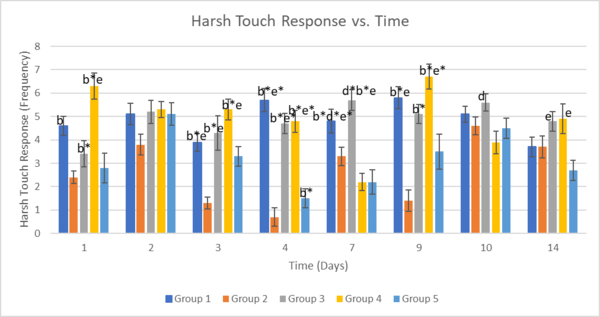 Figure 3: Harsh Touch Response vs. Time. The C. elegans assessed (n=50) were treated with different concentrations of astragalus: group 1 (control Wild-Type), group 2 (control NL5901), group 3 (2 mg/mL), group 4 (4 mg/mL), group 5 (8 mg/mL). The harsh gentle touch response frequency between different groups was compared with each other. ANOVA Tukey HSD was used to assess significant differences. The subscript is labeled after the key: a=significant from group 1, b=significant from group 2, c=significant from group 3, d=significant from group 4
Figure 3: Harsh Touch Response vs. Time. The C. elegans assessed (n=50) were treated with different concentrations of astragalus: group 1 (control Wild-Type), group 2 (control NL5901), group 3 (2 mg/mL), group 4 (4 mg/mL), group 5 (8 mg/mL). The harsh gentle touch response frequency between different groups was compared with each other. ANOVA Tukey HSD was used to assess significant differences. The subscript is labeled after the key: a=significant from group 1, b=significant from group 2, c=significant from group 3, d=significant from group 4
e=significant from group 5 (p<0.05). Combined subscripts are significantly different from multiple corresponding groups. Subscripts with asterisks (*) mean the p-value is less than 0.01. Groups on different days were not compared statistically with each other. On many occasions, groups 3 and 4 had a statistically significantly higher average than other groups. Groups 2 and 5 had the least average across the trial. Error bars represent ±SEM.
Figure 4: Thrashing Rate per second on Day 6 of data collection. The C. elegans assessed (n=50) were treated with different concentrations of astragalus: group 1 (control Wild-Type), group 2 (control NL5901), group 3 (2 mg/mL), group 4 (4 mg/mL), group 5 (8 mg/mL). The thrashing rate per second between different groups was compared with each other. ANOVA Tukey HSD was used to assess significant differences. The subscript is labeled after the key: a=significant from group 1, b=significant from group 2, c=significant from group 3, d=significant from group 4, e=significant from group 5 (p<0.05). Combined subscripts are significantly different from multiple corresponding groups. Subscripts with asterisks (*) mean the p-value is less than 0.01. Group 2 and Group 5 were significantly lower than other groups.
Discussion
This experiment assessed the mechanosensory responses of C. elegans through the selection of three different tests. In the first trial, for tap reflex, the percentage of all the groups was alike. The tap reflex was constantly changing between different days; however, group 4 consistently had the highest average on several days. Group 4 varied between 80% to 100% between separate days, exhibiting a higher consistent average than the wild control or NL5901 control group. As for gentle and harsh touch responses, group 4 appeared to react the most out of all the groups. Group 3 and Group 2 moved significantly less than group 4 in terms of gentle touch such as on days 2,7, 8, and others. Additionally for harsh touch, group 4 constantly had the highest movement average when compared with the other groups. Groups 2 and 3 moved the least in terms of harsh touch and although group 5 performed better than those two groups, it occasionally had a lower average than the wild-type control.
In trial 2, the tap reflex was again constantly changing between different days. Despite this, group 3 and 4 showed the highest averages throughout the trial. Group 2 consistently had the lowest average, which means that the treatment groups were able to generally perform better than the negative control. Gentle touch responses had more significant data within this trial, with group 3 and group 4 displaying more reactions towards the stimuli. On multiple days such as 5, 6, 12, 13 and others, group 3 and 4 had a significantly higher response compared to the control. This trend continued in the harsh touch sections of the trial. In the beginning, the experimental group had lower frequencies compared to control. However, the averages for groups 3 and 4 began to increase past the control and negative control. On day 12 and 13, the averages between groups 3 and 4 were statistically the same, but they were both significantly greater than all other groups. Additionally, there were many days where group 4 were significantly greater than group 3. Within trial 2, the thrashing rate was assessed after adding the M9 buffer on day 6. The control group were significantly higher than group 2, 3, and 4 which indicates that low concentrations of astragalus may not benefit thrashing rate.
In trial 3, tap reflex was inconsistent between different days. Through the 3 trials, tap reflex had no direct trend for any group. However, within trial 3, group 2 continuously had the lowest score in terms of tap reflex while group 1, 3 and 4 repeatedly had higher scores. As for gentle touch, treatment groups 3 and 4 had significantly higher averages than the negative control. On multiple days such as day 2, 7, 9 and 14, group 3 and 4 had significantly higher response compared to group 2 and were not significantly different from the wild-type group. Additionally, treatment group 5 had lower averages than the other two treatment groups. This implies that lower concentrations such as 2 mg/mL and 4 mg/mL may be more beneficial for PD inflicted worms than higher concentrations such as 8 mg/mL. The trend continued for harsh touch as group 5 had significantly low averages, second to group 2. Groups 3 and 4 displayed significantly higher averages than groups 2 and 5 on multiple occasions throughout the trials. As for thrashing rate after adding the M9 Buffer, groups 1, 3 and 4 were significantly greater than group 2 and 5. This contrasts with trial 2 which implied that higher concentrations of Astragalus benefits thrashing rate while these results indicate the opposite.
These results may indicate that 4 mg/mL may be the optimal concentration to combat PD. Within both trials 1 and 2, group 4 had the highest percentage for gentle touch and movement frequency for harsh touch. This aligns with past studies, 4.0 mg/ml of astragalus was able to preserve dopamine neurons and increase neuron fluorescence by 82.9% (Li et al., 2016). In addition, our study supports the finding that 2 mg/mL increases acetylcholinesterase activity which alleviates motor deficit. Group 3 had statistically less movement than the control groups and especially group 4 in trial 1. However, within trial 2, group 3 had increased movement throughout the trial and was significantly greater than group 2. Additionally, within trial 3, group 3 was able to perform significantly greater than group 2 and 5. Therefore, 2 mg/mL and 4 mg/mL were able to treat the symptoms of Parkinson’s inflicted worms, aligning with past studies.
There were many limitations within this experiment. Since the experiment took place in a school setting, no experiments occurred on weekends which led to losing out on multiple days of data. Additionally, the Petri-dishes had visible contamination with other organisms such as bacteria or mold which could affect the results of the study. To reduce contamination, the Petri-dishes should be opened minimally, and alcohol should be used more often to sterilize the tools used. In trial 2, disinfecting wipes and ethanol were used to sterilize the worm probe, toothpick, and workstation. Some data parameters were unmeasurable due to a lack of efficient methods or materials such as thrashing assessment and worm count. The original plan was to include worm count and thrashing assessment within the M9 Buffer. Worm count was excluded due to limited access to complex video and photo analysis of microscope photos that can focus and zoom out far enough to include every worm in the Petri dish. Thrashing assessment requires a worm pick and the techniques to transfer worms from a solid medium to a liquid medium which is difficult. In trial 2, this was remedied by assessing the thrashing rate after adding the M9 buffer directly into the Petri dish. Another limitation regarding thrashing rate occurred within trial 3. Thrashing rate was assessed on day 4, while in trial 2 data was collected on day 6. The day difference may pose a separate variable for thrashing rate. A digital camera specific to a microscope should also be used to make counting worms and tracking movement easier. In addition, although the tests were objective as possible, human error or bias is possible due to varying interpretations of the worm's movement.
Conclusion
The data best supports 2 mg/mL and 4 mg/mL as the optimal concentrations for treating PD after exhibiting the highest scores across the tests. Despite some inconsistencies, such as group 3 performing worse in trial 1, group 3 had increased their scores in trial 2 and 3 in gentle and harsh touch. This implies that lower concentrations may benefit the mechanosensory abilities of C. elegans. Group 4 consistently had the highest scores throughout all 3 trials. High concentrations such as 8 mg/mL had lower averages compared to 2 and 4 mg/mL, implying that higher concentrations of astragalus might be less effective at alleviating PD symptoms. As for locomotive behavior, the results in trials 2 and 3 contradict each other as 8 mg/mL performed better in trial 2 while in trial 3 lower concentrations had more movement. Therefore, the impact of Astragalus on locomotive behavior cannot be determined with this experiment's results. Overall, this experiment identifies lower and intermediate concentrations of Astragalus as more effective for alleviating symptoms of Parkinson’s Disease.
Future Direction
In the future, a prospective experiment could be conducted involving different concentrations of Astragalus with more tests to assess symptoms of PD. More tests that directly examine the dopamine neurons of the PD worms would allow further observations on how Astragalus protects them. Testing different concentrations will grant a deeper idea of the optimal dosage to alleviate such symptoms.
Acknowledgments
Thank you to Dr. D. Marmor, Mrs. N. Jaipershad, Dr. L. Wang, Dr. J. Cohen, Ms. J. Zhi, Dr. X. Lin, Mr. Z. Liang, Ms. A. Khemlani, and Ms. R. DePietro. Strains were provided by the CGC, which is funded by NIH Office of Research Infrastructure Programs (P40 OD01044).
References
Altun, Z.F. and Hall, D.H. (2009). Introduction. In WormAtlas. DOI: 10.3908/wormatlas.1.1
Anjaneyulu, J., R, V., & Godbole, A. (2020). Differential effect of Ayurvedic nootropics on C. elegans models of Parkinson's disease. Journal of Ayurveda and integrative medicine, 11(4), 440–447. DOI: 10.1016/j.jaim.2020.07.006
Apfeld, J., & Alper, S. (2018). What can we learn about human disease from the nematode C. elegans? Disease Gene Identification, 53-75. DOI: 10.1007/978-1-4939-7471-9_4
Baugh, L. R., & Hu, P. J. (2020). Starvation responses throughout the Caenorhabditis elegans life cycle. Genetics, 216(4), 837-878. DOI: 10.1534/genetics.120.303565
Bodhicharla, R., Nagarajan, A., Winter, J., Adenle, A., Nazir, A., Brady, D., ... & de Pomerai, D. (2012). Effects of α-synuclein overexpression in transgenic Caenorhabditis elegans strains. CNS & Neurological Disorders-Drug Targets (Formerly Current Drug Targets-CNS & Neurological Disorders), 11(8), 965-975. DOI: 10.2174/1871527311211080005
Cooper, J. F., & Van Raamsdonk, J. M. (2018). Modeling Parkinson’s Disease in C. elegans. Journal of Parkinson's disease, 8(1), 17-32. DOI: 10.3233/JPD-171258
Chalfie, M., & Sulston, J. (1981). Developmental genetics of the mechanosensory neurons of Caenorhabditis elegans. Developmental biology, 82(2), 358-370. DOI: 10.1016/0012-1606(81)90459-0
Di Rosa, G., Brunetti, G., Scuto, M., Trovato Salinaro, A., Calabrese, E. J., Crea, R., ... & Saul, N. (2020). Healthspan enhancement by olive polyphenols in C. elegans wild type and Parkinson’s models. International journal of molecular sciences, 21(11), 3893. DOI: 10.3390/ijms21113893
Dias, V., Junn, E., & Mouradian, M. M. (2013). The role of oxidative stress in Parkinson's disease. Journal of Parkinson's disease, 3(4), 461-491. DOI: 10.3233/JPD-130230
Filograna, R., Beltramini, M., Bubacco, L., & Bisaglia, M. (2016). Anti-oxidants in Parkinson’s disease therapy: a critical point of view. Current Neuropharmacology, 14(3), 260-271. DOI: 10.2174/1570159X13666151030102718
Ghosh, N., Ghosh, R., & Mandal, S. C. (2011). Antioxidant protection: A promising therapeutic intervention in neurodegenerative disease. Free Radical Research, 45(8), 888–905. DOI: 10.3109/10715762.2011.574290
Guo, J. D., Zhao, X., Li, Y., Li, G. R., & Liu, X. L. (2018). Damage to dopaminergic neurons by oxidative stress in Parkinson's disease. International journal of molecular medicine, 41(4), 1817-1825. DOI: 10.3892/ijmm.2018.3406
Huang, W. M., Liang, Y. Q., Tang, L. J., Ding, Y. U. E., & Wang, X. H. (2013). Antioxidant and anti-inflammatory effects of Astragalus polysaccharide on EA. hy926 cells. Experimental and therapeutic medicine, 6(1), 199-203. DOI: 10.3892/etm.2013.1074
Johnson, W. M., Wilson-Delfosse, A. L., & Mieyal, J. J. (2012). Dysregulation of glutathione homeostasis in neurodegenerative diseases. Nutrients, 4(10), 1399-1440. DOI: 10.3390/nu4101399
LeWitt, P. A. (2008). Levodopa for the treatment of Parkinson's disease. New England Journal of Medicine, 359(23), 2468-2476. DOI: 10.1056/NEJMct0800326
Li, H., Shi, R., Ding, F., Wang, H., Han, W., Ma, F., ... & Huang, Z. (2016). Astragalus polysaccharide suppresses 6-hydroxydopamine-induced neurotoxicity in Caenorhabditis elegans. Oxidative Medicine and Cellular Longevity, 2016. DOI: 10.1155/2016/4856761
Liu, H., Chen, S., Guo, C., Tang, W., Liu, W., & Liu, Y. (2018). Astragalus polysaccharide protects neurons and stabilizes mitochondrial in a mouse model of Parkinson disease. Medical Science Monitor: International Medical Journal of Experimental and Clinical Research, 24, 5192. DOI: 10.12659/MSM.908021
Maulik, M., Mitra, S., Bult-Ito, A., Taylor, B. E., & Vayndorf, E. M. (2017). Behavioral phenotyping and pathological indicators of Parkinson's disease in C. elegans models. Frontiers in genetics, 8, 77.
Oertel, W., & Schulz, J. B. (2016). Current and experimental treatments of Parkinson disease: A guide for neuroscientists. Journal of neurochemistry, 139, 325-337.
Sanyal, S., Wintle, R. F., Kindt, K. S., Nuttley, W. M., Arvan, R., Fitzmaurice, P., ... & Van Tol, H. H. (2004). Dopamine modulates the plasticity of mechanosensory responses in Caenorhabditis elegans. The EMBO journal, 23(2), 473-482.
Sekeroglu, N., & Gezici, S. (2019). Astragalus neurocarpus Bioss. as a potential source of natural enzyme inhibitor associated with Alzheimer’s and Parkinson diseases along with its rich polyphenolic content and antioxidant activities. Annals of Phytomedicine, 8(1), 82-87. DOI: 10.21276/ap.2019.8.1.9
Scheider, W. L., Hershey, L. A., Vena, J. E., Holmlund, T., Marshall, J. R., & Freudenheim, J. L. (1997). Dietary antioxidants and other dietary factors in the etiology of Parkinson's disease. Movement disorders, 12(2), 190-196. DOI: 10.1002/mds.870120209
Singh, N., Pillay, V., & Choonara, Y. E. (2007). Advances in the treatment of Parkinson's disease. Progress in neurobiology, 81(1), 29-44. DOI: 10.1016/j.pneurobio.2006.11.009
Statistics. Parkinson's Foundation. (n.d.). Retrieved January 27, 2022, from CrossRef
Stiernagle, T. Maintenance of C. elegans (February 11, 2006), WormBook, ed. The C. elegans Research Community, WormBook, DOI: 10.1895/wormbook.1.101.1, CrossRef.
Tohda, C., Tamura, T., Matsuyama, S., & Komatsu, K. (2006). Promotion of axonal maturation and prevention of memory loss in mice by extracts of Astragalus mongholicus. British journal of pharmacology, 149(5), 532-541. DOI: 10.1038/sj.bjp.0706865
U.S. Department of Health and Human Services. (n.d.). Parkinson's disease. National Institute on Aging. Retrieved January 27, 2022, from CrossRef
Yu, J., Ji, H. Y., & Liu, A. J. (2018). Alcohol-soluble polysaccharide from Astragalus membranaceus: Preparation, characteristics, and antitumor activity. International journal of biological macromolecules, 118, 2057-2064. DOI: 10.1016/j.ijbiomac.2018.07.073
Zhang, B., Xiao, R., Ronan, E. A., He, Y., Hsu, A. L., Liu, J., & Xu, X. S. (2015). Environmental temperature differentially modulates C. elegans longevity through a thermosensitive TRP channel. Cell reports, 11(9), 1414-1424. DOI: 10.1016/j.celrep.2015.04.066
Zheng, Y., Ren, W., Zhang, L., Zhang, Y., Liu, D., & Liu, Y. (2020). A review of the pharmacological action of Astragalus polysaccharide. Frontiers in pharmacology, 11, 349. DOI: 10.3389/fphar.2020.00349
Document information
Published on 27/05/23
Submitted on 27/05/23
Volume 5, 2023
Licence: CC BY-NC-SA license
Share this document
Keywords
claim authorship
Are you one of the authors of this document?
